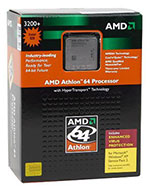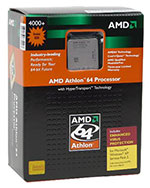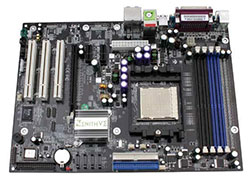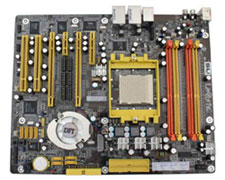Buyer's Guide: Mid-Range to High-End, May 2005
by Jarred Walton on May 23, 2005 5:30 PM EST- Posted in
- Guides
AMD Recommendations
AMD Processors
We covered the major differences between all of the currently shipping processor cores recently, and if you're not familiar with the various models, we would suggest that you give that a read. AMD arguably provides the best computing experience, both at the low end, the high end, and everything in between. However, their processor naming scheme can get a bit confusing, and especially the less experienced shoppers could end up with the wrong processor if they simply went by model numbers. There are no less than six currently shipping Athlon 64 3200+ chips, but we're only recommending one or two of those at present. Make sure that you get the right one!AMD Mid-Range Recommendation
Processor: Athlon 64 3200+ 90nm (Retail) - Winchester core
Price: $190 Shipped
The 3200+ remains to be the best option for socket 939, if you're trying to cut costs, yet still maintain a reasonable performance level. 2.0 GHz makes it 11% faster than the 3000+ and 9% slower than the 3500+. Although, the Winchester/Venice cores actually outperform Newcastle slightly clock for clock, so the 3500+ Newcastle may only be a few percent faster in certain applications (games, mostly). The 3000+ costs $146, and overclockers may be tempted to go that route rather than spend the extra $44. If you get a good motherboard and RAM for overclocking, the 3000+ may actually reach 2.5+ GHz, but it will require a 280+ MHz CPU bus speed compared to 250+ MHz for the 3200+. Depending on your overclocking skill, the 3200+ will probably get you farther than the 3000+. If you want to add SSE3 support, the Venice [RTPE: ADA3200BPBOX] cores cost an additional $20 relative to their Winchester [RTPE: ADA3200BIBOX] counterparts. SSE3 might help in certain encoding applications, and $20 isn't a major price difference, so it's definitely worth a thought. For now, we'll save the money for use elsewhere.
AMD High-End Recommendation
Processor: Athlon 64 4000+ 90nm (Retail) - San Diego core
Price: $507 Shipped
While the FX-55 remains the top-performing 939 part, we expect the new 90nm 4000+ [RTPE: ADA4000BNBOX] to give it a run for the money, particularly with overclocking. You may not be able to find the retail chips on sale right now, in which case, an OEM CPU is an option - overclockers are probably going to add a high-end HSF like the Zalman 7000 or Thermalright XP90 anyway. Some people feel that the retail chips are still a better choice for the improved warranty, and anecdotes of better overclocking with retail parts can be found on many forums. We're not sure if retail parts are actually better overclockers, but it's difficult to pass up on the 3-year warranty for a mere $18 increase. As a less expensive alternative that will still offer more performance than the 3200+ and 3500+, the new 3700+ [RTPE: ADA3700BNBOX] is definitely worth considering. The maximum overclocked speed is likely to be very similar to the 4000+, and it's quite a bit cheaper at $339. If you don't intend to overclock, of course, go with the fastest CPU that you can reasonably afford.
AMD Motherboards
If this were a budget guide, there would be many other options that we would consider, including boards using the VIA K8T890 and ATI Radeon Xpress 200 chipsets. For Mid-Range and above, nForce 3 and 4 are still our preferred choice. nForce 3 is on the way out, along with AGP, but if you have a good quality AGP card that you want to keep, it's a reasonable upgrade choice. For new systems, however, we recommend nForce 4 boards. The main difference between our Mid-Range and High End boards is the support (or lack thereof) for NVIDIA's SLI technology.AMD Mid-Range Recommendation
Motherboard: Chaintech VNF4 Ultra
Price: $89 Shipped
Considering the price difference (almost $20), we can't justify the additional cost for most of the competing nForce 4 Ultra motherboards. The Chaintech board lacks Firewire support, and the documentation and manual may not be the greatest, but it's still a high-performing board at a budget price. The Ultra model adds support for RAID and SATA2 as well as 1000 MHz HyperTransport, so we feel that it's worth the extra $2 relative to the nForce 4X model. Biostar, ECS, and Foxconn offer similarly equipped motherboards at a slightly higher price, but there's little reason to recommend their boards over the Chaintech - features and quality are very similar between these manufacturers in our experience, so we'll go with whatever's cheapest.
If you want additional features, ASUS, DFI, Gigabyte, MSI, and a few others make more expensive boards, and they certainly aren't a bad choice. DFI's Ultra board in particular is interesting, as it includes two physical PCIe X16 slots. While DFI doesn't ship an SLI connector and it may or may not be possible to mod the Ultra chip into an SLI chip, the board can still run dual graphics cards for multi-monitor support. DFI's boards also offer improved voltage ranges, which can help the overclockers, especially with RAM like the OCZ VX. Higher voltages mean more heat, which generally means more noise, so it's not something that everyone will appreciate. Still, most of these boards are at least $40 more than the Chaintech, so unless you really want the additional features, it's not worth the money. The nicer boards are also very close in price to some of the SLI boards, so at that point, you may as well go all the way to our High-End recommendation.
AMD High-End Recommendation
Motherboard: DFI LANPARTY UT nF4 SLI-DR
Price: $177 Shipped
For the high-performance enthusiast, SLI is the current crème de la crème, so an SLI motherboard is a must. The DFI Platinum board was co-winner of our Gold Editor's Choice award, and the differences between the UT and the "full version" are relatively minor. The UT doesn't include quite as many accessories, and the main omission is the front panel box and 5.1 audio instead of 7.1 audio; it also costs about $20 less. We don't feel that either of those features is really necessary, so we stuck with the standard model. The included Karajan sound module actually does quite well, so we don't see much need to purchase an add-in sound card for most users. The one issue worth mentioning on the DFI boards is that running with ultra-high voltages (using the 3.5V jumper) seems to cause some problems. That's only a concern for OCZ VX and Mushkin Redline users, really, and if you keep the voltage at stock you should be fine.
Honestly, all four SLI motherboards that we tested in our SLI Roundup (ASUS A8N Deluxe, Gigabyte GA-K8NXP-SLI, DFI LanParty SLI-DR, and MSI K8N Neo 4 Platinum SLI) are decent. The MSI board offers some great features, including the Sound Blaster 24-bit Live onboard audio. Unfortunately, we have recently discovered some performance issues when using the board with 90nm processors, so until MSI can release a BIOS update that addresses the issue, we would avoid the board. ASUS separates the two X16 slots by a larger margin, which should offer slightly better cooling for the top slot. However, it's a non-standard layout, and that could present problems in the future. We've already covered DFI, and Gigabyte has their "everything plus the kitchen sink" design. All four manufacturers are now offering "lite" versions of their SLI boards with reduced feature sets and prices, and in many cases, the missing features won't be missed. You can see the full list of SLI motherboards in our Pricing Engine. EPoX and Biostar also make SLI boards now, but we have not tested them, so we really can't comment on them other than to say they exist.
Update: After this Guide was initially written, it came to light that the MSI boards are having problems with 90nm parts. The MSI Neo4 SLI was our original high-end pick, but we changed that out after the new information. Sorry for the confusion!














60 Comments
View All Comments
CP5670 - Wednesday, May 25, 2005 - link
You can still get Mitsubishi 2070s (I got a new one for $600 about three weeks ago), although they are out of production and are somewhat hard to find.JarredWalton - Wednesday, May 25, 2005 - link
44 - Venice and Winchester seem to be the same chip, only with SSE3 enabled on Venice. I don't think it matters much for games right now, but with the difference only being $4 now, go for it. (At the time I wrote this Guide, Winchester retail chips were $20 less than Venice retail chips, which is harder to justify.)47 - I've emailed a few people about this, but basically there just aren't any improvements to CRTs coming out these days. You can still find some Dell, HP, etc. monitors that use the same tube as the NEC FE2111SB, and it's a good tube overall. The Mitsubishi 2070 still boasts the best specs I'm aware of (140 kHz horizontal scan rate and 2048x1536 resolution).
If you want a CRT, by all means get one. The Samsung 997DF is still a decent 19" model for around $210, though it's not perfectly flat. NEC FE991SB are also good, though they cost more than the Samsung. If you can find a discount on a Dell, HP, etc. CRT and it sports an aperture grille, it's probably going to be similar enough to the NEC/Mitsubishi models that you wouldn't notice other than the exterior.
Personally, I'm just tired of large CRTs, and I've recommended them in so many Guides (without any change) that it's time to move on. I'll continue to mention them, but I don't recommend them anymore for a lot of people.
CrimsonChaos - Wednesday, May 25, 2005 - link
Great guide!I was recently considering buying a system inbetween a mid-range and high-end computer. This would have been a tremendous help to me as I started the researching process.
Just a quick question -- why no PC Power & Cooling power supply for a high-end system? That too expensive even for the biggest enthusiast (aka money-waster)??
Also, going to add any normal CRT recommendations to the "Display" part?
Olaf van der Spek - Wednesday, May 25, 2005 - link
Re: 16> and I feel about the same for audio.
That's not a very strong argument.
But because audio is always integrated while video isn't, it's indeed simpler to add one later.
ceefka - Wednesday, May 25, 2005 - link
#43 Reapsy00,About every new CPU, mobo/chipset, graphicscard, RAM, LCD/CRT mentioned here has been benched, just not in this same article.
Also, recommendations here were winners in past benchmarkings before this article.
You'll even find links to benchmarks in the buyers guide. In my opinion AT has got it nailed pretty good.
dmaduram - Wednesday, May 25, 2005 - link
Kudos to Jarred for such an excellent guide -- it's quite informative!Just two quick questions -- first of all, with regard to gaming, is there an advantage in selecting a AMD-Venice core instead of a AMD-Wichester core? I was unsure on what specific applications recieved a boost from Venice's "SSE3" support.
Secondly, d'you know if there are any disadvantages in purchasing a Venice core instead of the recommended Wichester core? There's only a 4-dollar difference in price on NewEgg, so I was wondering which one I should buy for my gaming box :)
Reapsy00 - Wednesday, May 25, 2005 - link
You see lots of these buyer's guides on different sites, AT should take it further and build the system's and benchmark 'em.Calin - Wednesday, May 25, 2005 - link
No problem, TujanI wouldn't choose a VIA miniITX platform - the 1GHz processors are quite faster than the older 700-800MHz ones. However, their very size forces them to be niche systems.
If I would like a computer in my car, a MiniITX would be the best choice. But for a stand alone, I very much prefer upgradable PC technology
R3MF - Tuesday, May 24, 2005 - link
ah well, my new shuttle SN25P with a 3200 Venice, 6600GT (£98.00), and 250GB 7200.8 doesn't look too shabby.it even has onboard via-envy sound, and will be even better with a 7800GT and dual-core X2 early next year.
i am happy.
JarredWalton - Tuesday, May 24, 2005 - link
35 - Thanks. I wasn't aware of that. (I hate it when manufacturers do that!) Anyway, I added a comment about this in the article. Basically, I'm saying that RAM with TCCD blanks is still a great choice for overclockers looking for maximum clock speeds.